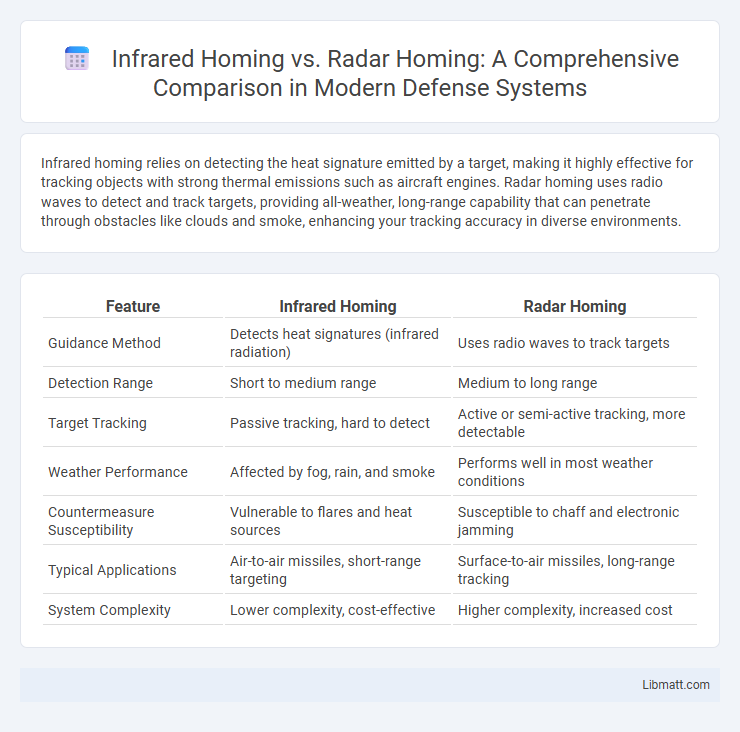Infrared homing relies on detecting the heat signature emitted by a target, making it highly effective for tracking objects with strong thermal emissions such as aircraft engines. Radar homing uses radio waves to detect and track targets, providing all-weather, long-range capability that can penetrate through obstacles like clouds and smoke, enhancing your tracking accuracy in diverse environments.
Table of Comparison
| Feature | Infrared Homing | Radar Homing |
|---|---|---|
| Guidance Method | Detects heat signatures (infrared radiation) | Uses radio waves to track targets |
| Detection Range | Short to medium range | Medium to long range |
| Target Tracking | Passive tracking, hard to detect | Active or semi-active tracking, more detectable |
| Weather Performance | Affected by fog, rain, and smoke | Performs well in most weather conditions |
| Countermeasure Susceptibility | Vulnerable to flares and heat sources | Susceptible to chaff and electronic jamming |
| Typical Applications | Air-to-air missiles, short-range targeting | Surface-to-air missiles, long-range tracking |
| System Complexity | Lower complexity, cost-effective | Higher complexity, increased cost |
Introduction to Infrared Homing and Radar Homing
Infrared homing utilizes the heat signature emitted by targets, enabling passive tracking without revealing the seeker's position. Radar homing involves active or semi-active emission of radio waves to detect and track objects, allowing long-range target acquisition and high accuracy. Both guidance systems play critical roles in missile technology, with infrared excelling in stealthy engagement and radar providing powerful situational awareness.
Fundamental Principles of Infrared Homing
Infrared homing relies on detecting and tracking heat signatures emitted by a target, using infrared sensors to capture thermal radiation in the electromagnetic spectrum. This method enables precise guidance by homing in on the target's infrared emissions, making it effective in night or low-visibility conditions where radar signals might be less reliable. Your choice between infrared and radar homing depends on mission requirements, as infrared provides passive tracking without revealing the missile's position.
Underlying Technology of Radar Homing
Radar homing relies on radio frequency waves emitted and reflected back by targets to determine their distance, speed, and direction, using Doppler shift and signal processing technology. This system allows for accurate target tracking in various weather conditions, as radar waves penetrate fog, rain, and smoke better than infrared signals. Your choice between infrared homing and radar homing should consider the operational environment and the technology's strengths in detection and guidance precision.
Key Differences: Passive vs Active Guidance
Infrared homing systems utilize passive guidance by detecting the heat signatures emitted from targets, requiring no signal emission that could reveal your position. Radar homing involves active guidance, sending out radio waves that bounce off targets to determine their location and movement. The passive nature of infrared makes it less detectable and ideal for stealth operations, while radar homing provides longer range and better all-weather capabilities.
Strengths and Limitations of Infrared Homing
Infrared homing offers precise target tracking by detecting heat signatures, making it highly effective in passive missile guidance without alerting the target. Its strength lies in resistance to radar jamming and the ability to lock onto fast-moving aircraft at close range, but its performance can be limited by environmental factors like weather conditions, smoke, or ground clutter. Your choice of missile guidance may depend on the infrared system's susceptibility to countermeasures and the requirement for stealth in engaging targets.
Advantages and Challenges of Radar Homing
Radar homing offers the advantage of operating effectively under various weather conditions and through obstacles such as smoke or fog, providing all-weather target tracking and long-range detection capabilities. It challenges include susceptibility to electronic countermeasures like jamming and the complexity of radar signal processing, which can increase system cost and weight. Despite these challenges, radar homing remains vital for precise guidance in hostile environments due to its accuracy and resistance to stealth tactics.
Countermeasures and Vulnerabilities Compared
Infrared homing systems are primarily vulnerable to heat-seeking countermeasures like flares, which can decoy the missile by simulating a target's thermal signature, while radar homing systems face jamming and stealth technology that disrupt or evade radar signals. Radar homing benefits from active signal detection at longer ranges but can be countered by electronic warfare tactics such as noise jamming or chaff deployment that confuse radar receivers. Understanding these vulnerabilities helps you assess the effectiveness and limitations of each targeting method in varying combat scenarios.
Applications in Modern Missile Systems
Infrared homing is widely used in modern short-range air-to-air and surface-to-air missiles due to its ability to detect heat signatures from aircraft engines and provide passive targeting without revealing the launcher's position. Radar homing is preferred in long-range missile systems, such as beyond-visual-range air-to-air and anti-ship missiles, because it can actively track and engage targets regardless of weather conditions or visibility. Combining both technologies in dual-mode seekers enhances target acquisition accuracy and countermeasure resistance in advanced missile defense systems.
Operational Scenarios: Infrared vs Radar Homing
Infrared homing excels in close-range engagements and stealth scenarios by detecting heat signatures, making it ideal for targeting aircraft engines or missiles in cluttered environments with minimal radar exposure. Radar homing operates effectively at longer distances and in adverse weather conditions, utilizing radio waves to track targets through obstacles and beyond visual range, which benefits beyond-visual-range missile systems and air defense interceptors. Your choice depends on mission requirements, whether prioritizing covert pursuit with infrared sensors or reliable tracking in all-weather conditions using radar guidance.
Future Trends in Homing Guidance Technologies
Future trends in homing guidance technologies are shifting towards advanced integration of infrared homing and radar homing systems, leveraging AI-driven sensor fusion to enhance target acquisition accuracy and reduce countermeasure susceptibility. Infrared homing developments focus on multi-spectral and hyperspectral imaging to improve detection in cluttered environments and low-visibility conditions. Radar homing is evolving with active electronically scanned array (AESA) radars for faster, more precise tracking and resistance to jamming, enabling your defense systems to achieve superior situational awareness and engagement effectiveness.
Infrared homing vs Radar homing Infographic

 libmatt.com
libmatt.com